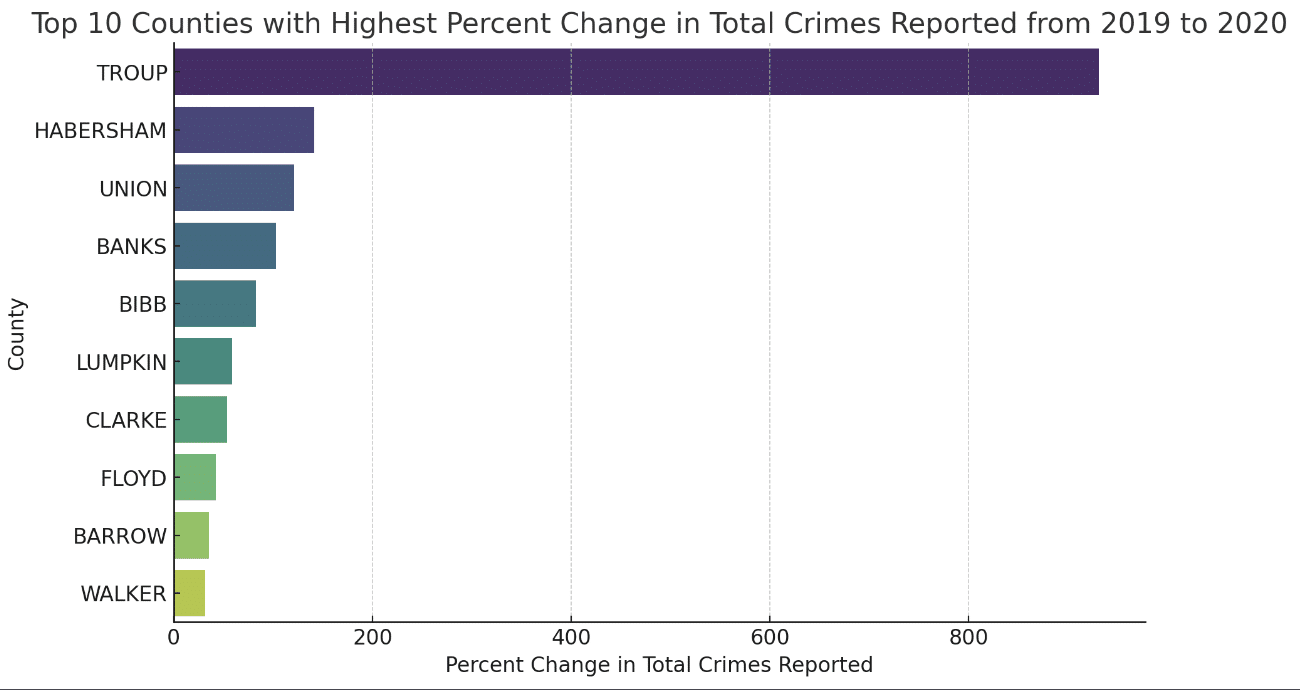Understanding the Shift in Crime Rates: A Comparative Analysis of Georgia Counties from 2019 to 2020
The subject of crime is a perennial concern for societies across the globe. It’s urgent to constantly monitor crime rates to devise effective crime prevention and law enforcement strategies. Here, we present an analysis of crime rates across different counties in Georgia for the years 2019 and 2020, with a special focus on the counties that have experienced the most significant changes.
Surge in Crime Rates: Spotlight on Top 10 Counties
Our analysis identified ten counties that have seen the most significant percent change in total reported crimes from 2019 to 2020. Leading the pack is Atkinson County, experiencing the most substantial increase in reported crimes. Following closely behind are Appling and Baldwin counties. The graph below presents these findings:

This bar chart represents the top ten counties that experienced the greatest percent change in total reported crimes. This percent change doesn’t necessarily indicate an absolute increase in crime, as various factors can influence it. These could include changes in population size, adjustments in reporting practices, and societal changes.
Interpreting the Shift
While the raw numbers can be startling, it’s important to delve deeper and seek possible explanations for these shifts in crime rates.
For instance, an increase in reported crimes could be due to improved reporting mechanisms and increased trust in law enforcement, leading more people to report crimes that would otherwise go unnoticed. Alternatively, it could be a reflection of societal changes, such as economic downturns, which can often lead to increases in certain types of crime.
Moreover, the impact of the COVID-19 pandemic cannot be overlooked. The pandemic and resultant lockdown measures have had significant social and economic impacts, which could potentially influence crime rates. For instance, decreases in certain types of crime, like burglary, could be due to more people staying at home, while increases in others, such as domestic violence, could be due to the stresses and strains of lockdown conditions.
Moving Forward
While the increases in reported crime in counties like Atkinson, Appling, and Baldwin demand attention, it’s compulsory to approach these figures with a nuanced perspective. Apprehending the context is key to interpreting these statistics and formulating effective responses.
Data like these underscore the importance of ongoing research and monitoring. By continually tracking crime rates, we can identify trends, understand the factors contributing to these trends, and eventually devise strategies that effectively address these issues, creating safer communities for all residents.
The analysis of crime rates from 2019 to 2020 across Georgia’s counties offers valuable insights. However, it also emphasizes the need for comprehensive and contextual understanding, reminding us that behind every statistic lies a complex interplay of societal, economic, and individual factors.
Data source: Georgia University Data